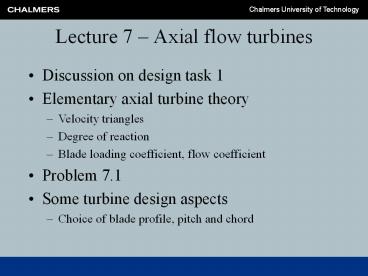Lecture 7 Axial flow turbines - PowerPoint PPT Presentation
Title:
Lecture 7 Axial flow turbines
Description:
Choice of blade profile, pitch and chord. Lecture 7 Axial ... 3D design - vortex theory. U ... Vortex blading. 3D optimized blading (design beyond free ... – PowerPoint PPT presentation
Number of Views:1536
Avg rating:3.0/5.0
Title: Lecture 7 Axial flow turbines
1
Lecture 7 Axial flow turbines
- Discussion on design task 1
- Elementary axial turbine theory
- Velocity triangles
- Degree of reaction
- Blade loading coefficient, flow coefficient
- Problem 7.1
- Some turbine design aspects
- Choice of blade profile, pitch and chord
2
Axial flow turbines
- Working fluid is accelerated by the stator and
decelerated by the rotor - Boundary layer growth and separation does not
limit stage loading as in axial compressor
- Expansion occurs in stator and in relative frame
of rotor
3
Elementary theory
- Energy equation for control volumes (again)
- Adiabatic expansion process (work extracted from
system - sign convention for added work w) - Rotor gt -w cp(T03-T02) ltgt w cp(T02-T03)
- Stator gt 0 cp(T02-T01) gt T02 T01
4
How is the temperature drop related to the blade
angles ?
- We study change of angular momentum at mid of
blade (as approximation)
5
Governing equations and assumptions
- Relative and absolute refererence frames are
related by
- We only study designs where
- Ca2Ca3
- C1C3
- You should know how to extend the equations!!!
- We repeat the derivation of theoretical work used
for radial and axial compressors
6
Principle of angular momentum
- Stage work output w
Ca constant
7
(No Transcript)
8
Energy equation
- Combine derived equations gt
Energy equation
We have a relation between temperature drop and
blade angles!!!
Exercise derive the correct expression when ?3
is small enough to allow ?3 to be pointing in the
direction of rotation.
9
Dimensionless parameters
Blade loading coefficient, temperature drop
coefficient
Degree of reaction
Exercise show that this expression is equal to
gt when C3 C1
10
? can be related to the blade angles!
C3 C1 gt
Relative to the rotor the flow does no work (in
the relative frame the blade is fixed). Thus
?T0,relative is constant gt
Exercise Verify this by using the definition of
the relative total temperature
11
? can be related to the blade angles!
Plugging in results in definition of ? gt
The parameter ? quantifies relative amount of
expansion in rotor. Thus, equation 7.7 relates
blade angles to the relative amount of
expansion. Aircraft turbine designs are typically
50 degree of reaction designs.
12
Dimensionless parameters
Finally, the flow coefficient
Current aircraft practice (according to C.R.S)
Aircraft practice gt relatively high values on
flow and stage loading coefficients limit
efficiencies
13
Dimensionless parameters
Using the flow coefficient in 7.6 and 7.7 we
obtain
The above equations and 7.1 can be used to obtain
the gas and blade angles as a function of the
dimensionless parameters
14
Two simple homework exercises
- Exercise show that the velocity triangles
become symmetric for ? 0.5. Hint combine 7.1
and 7.9 - Exercise use the current aircraft practice
rules to derive bounds for what would be
considered conventional aircraft turbine designs.
What will be the range for ?3? Assume ? 0.5.
15
Turbine loss coefficients
Nozzle (stator) loss coefficients
Nozzle (rotor) loss coefficients
16
Problem 7.1
17
3D design - vortex theory
- U varies with radius
- Cw velocity component at stator exit gt static
pressure increases with radius gt higher C2
velocity at root - Twist blades to take changing gas angles into
account - Vortex blading
3D optimized blading (design beyond free vortex
design)
18
3D design in steam turbines
- Keep blade angles from root to tip (unless rt/rr
high) - Cut cost
- Rankine cycle relatively insensitive to component
losses
19
Choice of blade profile, pitch and chord
- We want to find a blade that will minimize loss
and perform the required deflection - Losses are frequently separated in terms
20
Choice of blade profile, pitch and chord
- As for compressors - profile families are used
for thickness distributions. For instance - T6, C7 (British types)
21
Choice of blade profile, pitch and chord
- Velocity triangles determine gas angles not blade
angles. - arccos(o/s) should approximate outflow air
angle - Cascade testing shows a rather large range of
incidence angles for which both secondary and
profile losses are relatively insensitive
22
Choice of blade profile, pitch and chord
- Selection of pitch chord
- Blade loss must be minimized (the greater the
required deflection the smaller is the optimum
s/c - with respect to ?Profile loss) - Aspect ratio h/c. Not critical. Too low value gt
secondary flow and tip clearence effects in large
proportion. Too high gt vibration problems
likely. 3-4 typical. h/c lt 1 too low. - Effect on root fixing
- Pitch must not be too small to allow safe fixing
to turbine disc rim

